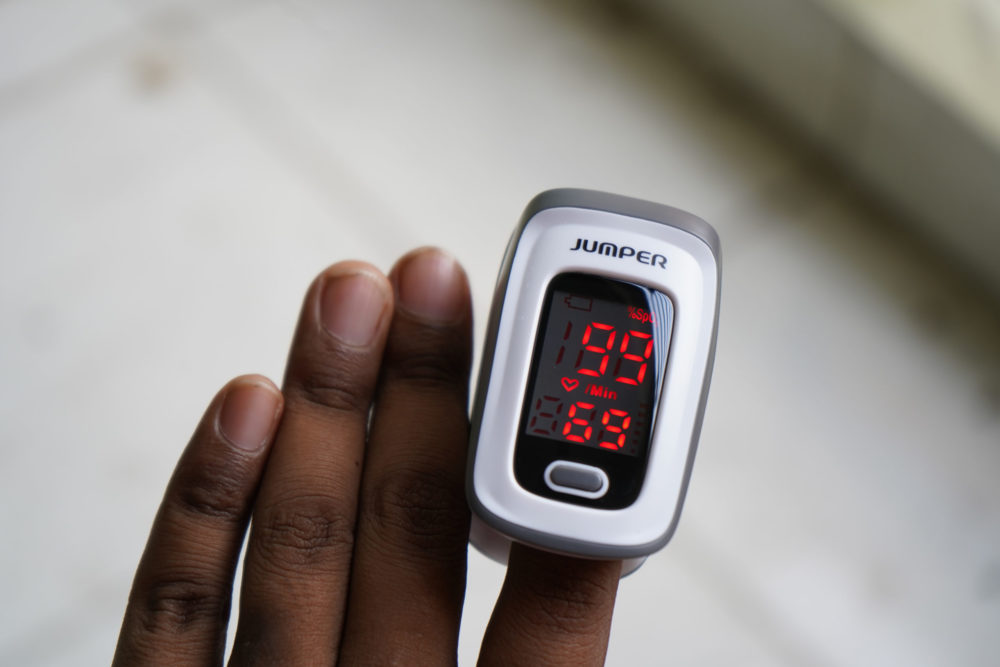Poorly Designed Pulse Oximeters Endangered Black and Latino Patients During Pandemic, Study Finds
Many Black and Latino patients received delayed care for COVID-19 due to poorly designed pulse oximeters, researchers warn

People of color often fail to receive life-saving treatments for COVID-19, because pulse oximeters used to monitor their vitals do not accurately read darker skin tones, sometimes resulting in a failure to diagnose the illness, according to the findings of a new study.
Pulse oximeters are used to read oxygen levels in hospital and clinical settings. However, researchers from Johns Hopkins University School of Medicine warn that the devices are flawed, and provide inaccurate readings for Black, Latino and Asian Americans compared to white patients. The findings were published May 31, in the journal JAMA Internal Medicine.
The inaccurate readings make it difficult for people of color to receive proper medical attention, and at times, life-saving medical attention, during the COVID-19 pandemic. The devices, ubiquitous throughout the medical system, can make patients of color seem healthier than they really are, the study warns.
The researchers conducted a retrospective study of 7,100 patients with COVID-19 from five medical centers and community hospitals in the Johns Hopkins Health System. They compared data of patients’ oxygen saturation levels by using pulse oximetry and arterial blood gas, a much more invasive approach.
The data indicated pulse oximetry overestimated blood oxygen levels among Asian, Black, and Hispanic patients compared with white patients. Pulse oximetry failed to identify Black and Latino patients who meet qualifications to receive COVID-19 therapy based on their oxygen levels. This led to significant delays in treatment.
Overall, 30% of Asian patients, 29% of Black patients and 30% of Latino patients suffered hypoxia, or a dangerously low level of oxygen in the blood, which is a sign of breathing or circulation problems, especially important during the pandemic. Comparatively, only 17% of white patients suffered hypoxia.
Black patients had a 29% increased risk of not receiving timely treatment. Among Latinos, their risk was 23% compared to white patients. Blood oximeters overestimated blood oxygen levels by about 2% among Asian patients, 1% in Black patients and 1% among Latino patients.
Among 451 patients, 23% never had their eligibility for treatment recognized based on blood oximeter levels. Of those patients, 54% were Black. On average, Black patients often had to wait one hour or more compared to white patients to have treatment eligibility recognized.
“The results of this cohort study suggest that racial and ethnic biases in pulse oximetry accuracy were associated with greater occult hypoxemia in Asian, Black, and non-Black Hispanic patients with COVID-19, which was associated with significantly delayed or unrecognized eligibility for COVID-19 therapies among Black and Hispanic patients,” the researchers determined. “This disparity may contribute to worse outcomes among Black and Hispanic patients with COVID-19.”

Did You Know?
Millions of Philips CPAP Machines Recalled
Philips DreamStation, CPAP and BiPAP machines sold in recent years may pose a risk of cancer, lung damage and other injuries.
Learn MorePulse oximeters are devices placed on the patient’s finger to detect a person’s oxygen levels by the way the light is absorbed by the skin. Pulse oximetry helps with triage and treatment decisions for many medical conditions, but especially for COVID-19.
According to previous research, darker skin and even dark nail polish can skew the reading. Reports of disparities among patients of color date back to the 1990s, yet nothing has changed.
During the pandemic pulse oximeters have been extremely important in helping to determine the severity of COVID, but patients of color would receive treatment at much later times based on the flawed technology. Researchers warn the device is necessary for the medical community, but the technology must be updated to properly serve all patients, including those of color.
Get more articles like this sent directly to your inbox.
"*" indicates required fields
2 Comments





paulJanuary 26, 2023 at 3:53 pm
Wow
DawnJuly 9, 2022 at 8:16 pm
Is there a class action lawsuit for this? I had blood clots and was told I was fine because my OX level was 97. I showed her a picture of my home ox and it said 89 but they ignored it. It should not be used if it not for all patients. Period